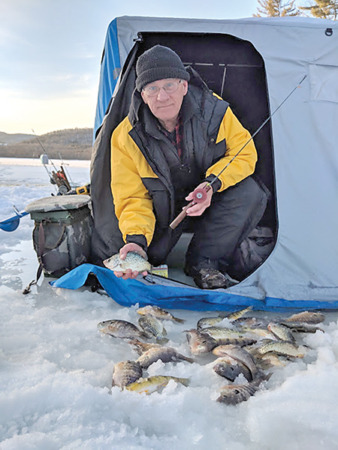Back in December we hard water walkers weren’t too sure we were going to have much of an ice fishing season, but it turns out we are having one of our longest seasons in a while. Even as I write this piece, I’m planning a couple more trips to area lakes in search of my favorite winter species — panfish. Odd as it may seem I may not be packing my ice fishing gear away until the second week of March and I might be wading a nearby trout stream with a flyrod during the third week of March.
I’m anxious to hit the trout streams but trust me, I’m still quite content to ice some more panfish before the ice gets too thin. People often ask, “Do you guys actually catch fish through a hole in the ice”? The truth is, yes we do. Depending on the lake taking a good number of fish through the ice is not at all uncommon. Like all kinds of fishing, it pays to have the right equipment and to use it most productively. A few weeks ago I mentioned the importance of having and knowing how to use a sonar unit — while it doesn’t guarantee more hooked fish it does tell you where they are in the water column.
Of course one of the most important factors is the proper rod rigged appropriately, and that holds true for any kind of fishing for that matter. For ice fishing, a short rod — say two feet or less is best combined with a simple reel and two or four-pound test line for panfishing. Most of the frozen chosen will use a tiny ice jig usually baited with a wax worm, mealworm, maggot or some other live bait. I often use the same rig, but in recent years I’ve added some variations to help increase my catch.
Something I’ve done to help increase my catch is to fish two or even three ice jigs on a single outfit. I usually start with a tungsten jig at the terminal end; I especially like the gold tungsten jigs. Tungsten is heavier than lead and will sink faster to the desired depth. About a foot and a half further up I tie on a second jig — usually a lead jig with some color on a very short length of line — maybe an inch and a half. Sometimes I’ll use a third jig further up the line. I bait all of the jigs with some live bait. This rig allows me to actually fish several depths at the same time. What’s really fun is when two fish grab your rigs at the same time, and you end up pulling two fish up out of the hole; that very scenario has happened four times already this year.
Most of the time I fish my double or triple rig simply by holding the rod in my hand and “feeling” for the slightest touch or tick. No gloves by the way since wearing gloves dampens the sensitivity. The slightest tick triggers a hook set and hopefully a hooked fish. In addition to feeling the strike, I also watch the line intently. If the line is centered in the ice hole and I see it move towards the side of the hole I set the hook. I often fish two rods at the same time — one I’m holding, and the other is rigged with a small bobber and secured within easy reach. Any movement of the bobber should result in a quick strike.
If you don’t get a chance to get on the ice and try some of these techniques this year don’t sweat it because in a few weeks we will be wading a trout stream with a flyrod and a totally different approach. Fishing — it just never seems to end.





Leave a Comment
Your email address will not be published. Required fields are marked with *